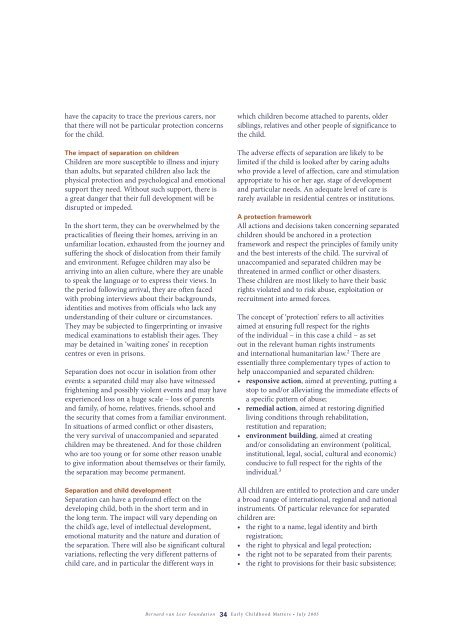Responses to young children in post-emergency situations
Responses to young children in post-emergency situations
Responses to young children in post-emergency situations
You also want an ePaper? Increase the reach of your titles
YUMPU automatically turns print PDFs into web optimized ePapers that Google loves.
have the capacity <strong>to</strong> trace the previous carers, nor<br />
that there will not be particular protection concerns<br />
for the child.<br />
The impact of separation on <strong>children</strong><br />
Children are more susceptible <strong>to</strong> illness and <strong>in</strong>jury<br />
than adults, but separated <strong>children</strong> also lack the<br />
physical protection and psychological and emotional<br />
support they need. Without such support, there is<br />
a great danger that their full development will be<br />
disrupted or impeded.<br />
In the short term, they can be overwhelmed by the<br />
practicalities of flee<strong>in</strong>g their homes, arriv<strong>in</strong>g <strong>in</strong> an<br />
unfamiliar location, exhausted from the journey and<br />
suffer<strong>in</strong>g the shock of dislocation from their family<br />
and environment. Refugee <strong>children</strong> may also be<br />
arriv<strong>in</strong>g <strong>in</strong><strong>to</strong> an alien culture, where they are unable<br />
<strong>to</strong> speak the language or <strong>to</strong> express their views. In<br />
the period follow<strong>in</strong>g arrival, they are often faced<br />
with prob<strong>in</strong>g <strong>in</strong>terviews about their backgrounds,<br />
identities and motives from officials who lack any<br />
understand<strong>in</strong>g of their culture or circumstances.<br />
They may be subjected <strong>to</strong> f<strong>in</strong>gerpr<strong>in</strong>t<strong>in</strong>g or <strong>in</strong>vasive<br />
medical exam<strong>in</strong>ations <strong>to</strong> establish their ages. They<br />
may be deta<strong>in</strong>ed <strong>in</strong> ‘wait<strong>in</strong>g zones’ <strong>in</strong> reception<br />
centres or even <strong>in</strong> prisons.<br />
Separation does not occur <strong>in</strong> isolation from other<br />
events: a separated child may also have witnessed<br />
frighten<strong>in</strong>g and possibly violent events and may have<br />
experienced loss on a huge scale – loss of parents<br />
and family, of home, relatives, friends, school and<br />
the security that comes from a familiar environment.<br />
In <strong>situations</strong> of armed conflict or other disasters,<br />
the very survival of unaccompanied and separated<br />
<strong>children</strong> may be threatened. And for those <strong>children</strong><br />
who are <strong>to</strong>o <strong>young</strong> or for some other reason unable<br />
<strong>to</strong> give <strong>in</strong>formation about themselves or their family,<br />
the separation may become permanent.<br />
Separation and child development<br />
Separation can have a profound effect on the<br />
develop<strong>in</strong>g child, both <strong>in</strong> the short term and <strong>in</strong><br />
the long term. The impact will vary depend<strong>in</strong>g on<br />
the child’s age, level of <strong>in</strong>tellectual development,<br />
emotional maturity and the nature and duration of<br />
the separation. There will also be significant cultural<br />
variations, reflect<strong>in</strong>g the very different patterns of<br />
child care, and <strong>in</strong> particular the different ways <strong>in</strong><br />
which <strong>children</strong> become attached <strong>to</strong> parents, older<br />
sibl<strong>in</strong>gs, relatives and other people of significance <strong>to</strong><br />
the child.<br />
The adverse effects of separation are likely <strong>to</strong> be<br />
limited if the child is looked after by car<strong>in</strong>g adults<br />
who provide a level of affection, care and stimulation<br />
appropriate <strong>to</strong> his or her age, stage of development<br />
and particular needs. An adequate level of care is<br />
rarely available <strong>in</strong> residential centres or <strong>in</strong>stitutions.<br />
A protection framework<br />
All actions and decisions taken concern<strong>in</strong>g separated<br />
<strong>children</strong> should be anchored <strong>in</strong> a protection<br />
framework and respect the pr<strong>in</strong>ciples of family unity<br />
and the best <strong>in</strong>terests of the child. The survival of<br />
unaccompanied and separated <strong>children</strong> may be<br />
threatened <strong>in</strong> armed conflict or other disasters.<br />
These <strong>children</strong> are most likely <strong>to</strong> have their basic<br />
rights violated and <strong>to</strong> risk abuse, exploitation or<br />
recruitment <strong>in</strong><strong>to</strong> armed forces.<br />
The concept of ‘protection’ refers <strong>to</strong> all activities<br />
aimed at ensur<strong>in</strong>g full respect for the rights<br />
of the <strong>in</strong>dividual – <strong>in</strong> this case a child – as set<br />
out <strong>in</strong> the relevant human rights <strong>in</strong>struments<br />
and <strong>in</strong>ternational humanitarian law. 2 There are<br />
essentially three complementary types of action <strong>to</strong><br />
help unaccompanied and separated <strong>children</strong>:<br />
• responsive action, aimed at prevent<strong>in</strong>g, putt<strong>in</strong>g a<br />
s<strong>to</strong>p <strong>to</strong> and/or alleviat<strong>in</strong>g the immediate effects of<br />
a specific pattern of abuse;<br />
• remedial action, aimed at res<strong>to</strong>r<strong>in</strong>g dignified<br />
liv<strong>in</strong>g conditions through rehabilitation,<br />
restitution and reparation;<br />
• environment build<strong>in</strong>g, aimed at creat<strong>in</strong>g<br />
and/or consolidat<strong>in</strong>g an environment (political,<br />
<strong>in</strong>stitutional, legal, social, cultural and economic)<br />
conducive <strong>to</strong> full respect for the rights of the<br />
<strong>in</strong>dividual. 3<br />
All <strong>children</strong> are entitled <strong>to</strong> protection and care under<br />
a broad range of <strong>in</strong>ternational, regional and national<br />
<strong>in</strong>struments. Of particular relevance for separated<br />
<strong>children</strong> are:<br />
• the right <strong>to</strong> a name, legal identity and birth<br />
registration;<br />
• the right <strong>to</strong> physical and legal protection;<br />
• the right not <strong>to</strong> be separated from their parents;<br />
• the right <strong>to</strong> provisions for their basic subsistence;<br />
B e r n a r d v a n L e e r Fo u n d a t i o n 34 E a r l y C h i l d h o o d M a t t e r s • Ju l y 2 0 0 5
















